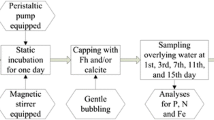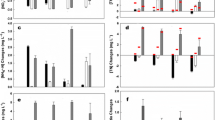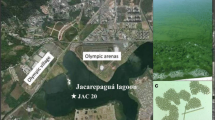Abstract
This study aimed to assess the effectiveness of capping and mixing of calcined dolomite and zeolite for the remediation of sediment contaminated with nitrogen (N) and phosphorus (P). Laboratory incubation experiments were performed to monitor the release of NH4-N, NO3-N, T-N, PO4-P, and T-P from the sediment. pH, electric conductivity (EC), oxidation reduction potential (ORP), and dissolved oxygen (DO) in overlying water for 60 days were evaluated. Dolomite-amended sediment has high pH and EC. Zeolite and dolomite capping effectively interrupted the release of N and P, respectively; capping was found to be more effective than mixing. The mixture of dolomite and zeolite was also effective; however, their efficiencies were influenced by their placement. The remediation efficiencies when the dolomite was placed above the zeolite cap layer (DOL/ZEO_CAP) were 95.9%, 101.6%, and 100.2% for NH4-N, PO4-P, and total, and the total remediation efficiency of DOL/ZEO_CAP was twice that of the opposite placement (ZEO/DOL_CAP). Low remediation efficiencies for NH4-N and T-N were observed in ZEO/DOL_CAP because NH4+ adsorption on zeolite was hindered by Ca2+ and Mg2+ released from the dolomite. The combination of dolomite and zeolite can be used as a capping material for simultaneously interrupting the release of both nitrogen and phosphorus, but their placement should be considered.






Similar content being viewed by others
References
Abel S, Nybom I, Mäenpää K, Hale SE, Cornelissen G, Akkanen J (2017) Mixing and capping techniques for activated carbon based sediment remediation–efficiency and adverse effects for Lumbriculus variegatus. Water Res 114:104–112
Adam F, Wong JT, Ng EP (2013) Fast catalytic oxidation of phenol over iron modified zeolite L nanocrystals. Chem Eng J 214:63–67
Agarwal S, Al-Abed SR, Dionysiou DD (2007) In situ technologies for reclamation of PCB-contaminated sediments: current challenges and research thrust areas. J Environ Eng 133(12):1075–1078
Bellier N, Chazarenc F, Comeau Y (2006) Phosphorus removal from wastewater by mineral apatite. Water Res 40(15):2965–2971
Berg U, Neumann T, Donnert D, Nüesch R, Stüben D (2004) Sediment capping in eutrophic lakes–efficiency of undisturbed calcite barriers to immobilize phosphorus. Appl Geochem 19(11):1759–1771
Beutel MW (2006) Inhibition of ammonia release from anoxic profundal sediments in lakes using hypolimnetic oxygenation. Ecol Eng 28(3):271–279
Bhagowati B, Ahamad KU (2019) A review on lake eutrophication dynamics and recent developments in lake modeling. Ecohydrol Hydrobiol 19(1):155–166
Calugaru IL, Neculita CM, Genty T, Bussière B, Potvin R (2016) Performance of thermally activated dolomite for the treatment of Ni and Zn in contaminated neutral drainage. J Hazard Mater 310:48–55
Cho YM, Smithenry DW, Ghosh U, Kennedy AJ, Millward RN, Bridges TS, Luthy RG (2007) Field methods for amending marine sediment with activated carbon and assessing treatment effectiveness. Mar Environ Res 64(5):541–555
Cho YM, Ghosh U, Kennedy AJ, Grossman A, Ray G, Tomaszewski JE, Luthy RG (2009) Field application of activated carbon amendment for in-situ stabilization of polychlorinated biphenyls in marine sediment. Environ Sci Technol 43(10):3815–3823
Colella C (1996) Ion exchange equilibria in zeolite minerals. Mineral Deposita 31(6):554–562
Conley DJ, Paerl HW, Howarth RW, Boesch DF, Seitzinger SP, Haven KE, Lancelot C, Gene E (2009) Controlling eutrophication: nitrogen and phosphorus. Science 123:1014–1015
Cooney EL, Booker NA, Shallcross DC, Stevens GW (1999) Ammonia removal from wastewaters using natural Australian zeolite. I Characterization of the zeolite. Sep Sci Technol 34(12):2307–2327
Cornelissen G, Elmquist Kruså M, Breedveld GD, Eek E, Oen AM, Arp HPH, Gunnarsson JS (2011) Remediation of contaminated marine sediment using thin-layer capping with activated carbon ˗ a field experiment in Trondheim Harbor, Norway. Environ Sci Technol 45(14):6110–6116
Di Toro DM (2001) Sediment flux modeling, vol 116. Wiley-Interscience, New York
Eek E, Godøy O, Aagaard P, Breedveld GD (2007) Experimental determination of efficiency of cappingmaterials during consolidation of metalcontaminated dredged material. Chemosphere 69(5): 719–728.
Fan Y, Li Y, Wu D, Li C, Kong H (2017) Application of zeolite/hydrous zirconia composite as a novel sediment capping material to immobilize phosphorus. Water Res 123:1–11
Gaillard F, Marziano GI (2005) Electrical conductivity of magma in the course of crystallization controlled by their residual liquid composition. J Geophys Res B Solid Earth 110: B06204
Gu BW, Lee CG, Lee TG, Park SJ (2017) Evaluation of sediment capping with activated carbon and nonwoven fabric mat to interrupt nutrient release from lake sediments. Sci Total Environ 599:413–421
Gu BW, Hong SH, Lee CG, Park SJ (2019) The feasibility of using bentonite, illite, and zeolite as capping materials to stabilize nutrients and interrupt their release from contaminated lake sediments. Chemosphere 219:217–226
Guaya D, Valderrama C, Farran A, Armijos C, Cortina JL (2015) Simultaneous phosphate and ammonium removal from aqueous solution by a hydrated aluminum oxide modified natural zeolite. Chem Eng J 271:204–213
Gutiérrez-Paredes J, Romero-Serrano A, Plascencia-Barrera G, Vargas-Ramírez M, Zeifert B, Arredondo-Torres V (2005) Chromium oxide reduction from slag by silicon and magnesium. Steel Res Int 76(11):764–768
Han J, Ro HM, Cho KH, Kim KW (2016) Fluxes of nutrients and trace metals across the sediment-water interface controlled by sediment-capping agents: bentonite and sand. Environ Monit Assess 188(10):566
Hantush MM, Kalin L (2014) Modeling nitrogen fate and transport at the sediment-water interface. In: Modelling and simulation of diffusive processes. Springer, Cham, pp 161–185
Hong SH, Lee JI, Lee CG, Park SJ (2019) Effect of temperature on capping efficiency of zeolite and activated carbon under fabric mats for interrupting nutrient release from sediments. Sci Rep 9(15754):1–11
Huang H, Xiao X, Yan B, Yang L (2010) Ammonium removal from aqueous solutions by using natural Chinese (Chende) zeolite as adsorbent. J Hazard Mater 175(1–3):247–252
Jacobs PH, Förstner U (1999) Concept of subaqueous capping of contaminated sediments with active barrier systems (ABS) using natural and modified zeolites. Water Res 33(9):2083–2087
Jacobs PH, Waite TD (2004) The role of aqueous iron (II) and manganese (II) in sub-aqueous active barrier systems containing natural clinoptilolite. Chemosphere 54(3):313–324
Karaca S, Gürses A, Ejder M, Açıkyıldız M (2004) Kinetic modeling of liquid-phase adsorption of phosphate on dolomite. J Colloid Interface Sci 277(2):257–263
Karaca S, Gürses A, Ejder M, Açıkyıldız M (2006) Adsorptive removal of phosphate from aqueous solutions using raw and calcinated dolomite. J Hazard Mater 128(2–3):273–279
Kim MJ, Lee JH, Park SJ (2018) Manufacture of high efficiency phosphate adsorbent by thermal treatment of dolomite. KSWST J Water Treat 26(1):69–78
Kim MJ, Hong SH, Lee JI, Lee CG, Park SJ (2019) Removal of fluoride from water using thermally treated dolomite and optimization of experimental conditions using response surface methodology. Desalin Water Treat 155:311–320
Knox AS, Paller MH, Reible DD, Ma X, Petrisor IG (2008) Sequestering agents for active caps–remediation of metals and organics. Soil Sediment Contam 17(5):516–532
Kocaoba S (2007) Comparison of Amberlite IR 120 and dolomite’s performances for removal of heavy metals. J Hazard Mater 147(1–2):488–496
Lee CG, Alvarez PJ, Kim HG, Jeong S, Lee S, Lee KB, Choi JW (2018a) Phosphorous recovery from sewage sludge using calcium silicate hydrates. Chemosphere 193:1087–1093
Lee MH, Jung HJ, Kim SH, An SU, Choi JH, Lee HJ, Hur J (2018b) Potential linkage between sediment oxygen demand and pore water chemistry in weir-impounded rivers. Sci Total Environ 619:1608–1617
Lee TG, Lee CG, Hong SG, Kim JH, Park SJ (2019) Water and soil properties in organic and conventional paddies throughout the rice cultivation cycle in South Korea. Environ Eng Res 24(1):45–53
Leyva-Ramos R, Jacobo-Azuara A, Diaz-Flores PE, Guerrero-Coronado RM, Mendoza-Barron J, Berber-Mendoza MS (2008) Adsorption of chromium(VI) from an aqueous solution on a surfactant-modified zeolite. Colloids Surf A Physicochem Eng Asp 330(1):35–41
Li Y, Fan Y, Li X, Wu D (2017) Evaluation of zeolite/hydrous aluminum oxide as a sediment capping agent to reduce nutrients level in a pond. Ecol Eng 101:170–178
Lin J, Zhan Y, Zhu Z (2011) Evaluation of sediment capping with active barrier systems (ABS) using calcite/zeolite mixtures to simultaneously manage phosphorus and ammonium release. Sci Total Environ 409(3):638–646
Liu T, Wang H, Zhang Z, Zhao D (2017) Application of synthetic iron-oxide coated zeolite for the pollution control of river sediments. Chemosphere 180:160–168
Lu SG, Bai SQ, Zhu L, Shan HD (2009) Removal mechanism of phosphate from aqueous solution by fly ash. J Hazard Mater 161(1):95–101
Marañón E, Ulmanu M, Fernández Y, Anger I, Castrillón L (2006) Removal of ammonium from aqueous solutions with volcanic tuff. J Hazard Mater 137(3):1402–1409
McBride MB (1994) Environmental chemistry of soils. Oxford University Press, New York
Medrano JA, Garofalo A, Donato L, Basile F, De Santo MP, Gallucci F, Algieri C (2018) CO selective oxidation using catalytic zeolite membranes. Chem Eng J 351:40–47
Miskimmin BM, Donahue WF, Watson D (1995) Invertebrate community response to experimental lime (Ca (OH) 2) treatment of an eutrophic pond. Aquat Sci 57(1):20–30
Montégut G, Michelin L, Brendlé J, Lebeau B, Patarin J (2016) Ammonium and potassium removal from swine liquid manure using clinoptilolite, chabazite and faujasite zeolites. J Environ Manag 167:147–155
Mulligan CN, Fukue M, Sato Y (2009) Chapter 5. Natural recovery of contaminated sediments, In: Sediments contamination and sustainable remediation. CRC Press, New York
Näslund JSGS, Samuelsson GS, Gunnarsson JS, Nascimento FJ, Nilsson HC, Cornelissen G, Schaanning MT (2012) Ecosystem effects of materials proposed for thin-layer capping of contaminated sediments. Mar Ecol Prog Ser 449:27–39
Nezamzadeh-Ejhieh A, Moeinirad S (2011) Heterogeneous photocatalytic degradation of furfural using NiS-clinoptilolite zeolite. Desalination 273(2–3):248–257
Nyenje PM, Foppen JW, Uhlenbrook S, Kulabako R, Muwanga A (2010) Eutrophication and nutrient release in urban areas of sub-Saharan Africa—a review. Sci Total Environ 408(3):447–455
Okano K, Uemoto M, Kagami J, Miura K, Aketo T, Toda M, Ohtake H (2013) Novel technique for phosphorus recovery from aqueous solutions using amorphous calcium silicate hydrates (A-CSHs). Water Res 47(7):2251–2259
Paerl HW, Xu H, McCarthy MJ, Zhu G, Qin B, Li Y, Gardner WS (2011) Controlling harmful cyanobacterial blooms in a hyper-eutrophic Lake (Lake Taihu, China): the need for a dual nutrient (N & P) management strategy. Water Res 45(5):1973–1983
Perelo LW (2010) In situ and bioremediation of organic pollutants in aquatic sediments. J Hazard Mater 177(1–3):81–89
Prepas EE, Pinel-Alloul B, Chambers PA, Murphy TP, Reedyk S, Sandland G, Serediak M (2001) Lime treatment and its effects on the chemistry and biota of hardwater eutrophic lakes. Freshw Biol 46(8):1049–1060
Prochaska CA, Zouboulis AI (2006) Removal of phosphates by pilot vertical-flow constructed wetlands using a mixture of sand and dolomite as substrate. Ecol Eng 26(3):293–303
Rakoczy RA, Traa Y (2003) Nanocrystalline zeolite A: synthesis, ion exchange and dealumination. Microporous Mesoporous Mater 60(1–3):69–78
Rubiera F, Fuertes AB, Pis JJ, Artos V, Marban G (1991) Changes in textural properties of limestone and dolomite during calcination. Thermochim Acta 179:125–134
Samuelsson GS, Hedman JE, Kruså ME, Gunnarsson JS, Cornelissen G (2015) Capping in situ with activated carbon in Trondheim harbor (Norway) reduces bioaccumulation of PCBs and PAHs in marine sediment fauna. Mar Environ Res 109:103–112
Sasaki K, Yoshida M, Ahmmad B, Fukumoto N, Hirajima T (2013) Sorption of fluoride on partially calcined dolomite. Colloids Surf A Physicochem Eng Asp 435:56–62
Schaanning M, Breyholtz B, Skei J (2006) Experimental results on effects of capping on fluxes of persistent organic pollutants (POPs) from historically contaminated sediments. Mar Chem 102(1–2):46–59
Sokić M, Matković V, Marković B, Gulišija Z, Patarić A, Mihailović M, Janjušević Z (2014) The possibilities of obtaining metallic calcium from Serbian carbonate mineral raw materials. Chem Ind Chem Eng Q 20(3):397–405
Søndergaard M, Jensen JP, Jeppesen E (2003) Role of sediment and internal loading of phosphorus in shallow lakes. Hydrobiologia 506(1–3):135–145
Sprynskyy M, Lebedynets M, Terzyk AP, Kowalczyk P, Namieśnik J, Buszewski B (2005) Ammonium sorption from aqueous solutions by the natural zeolite Transcarpathian clinoptilolite studied under dynamic conditions. J Colloid Interface Sci 284(2):408–415
Taşyürek K, Buğdaycı M, Yücel O (2018) Reduction conditions of metallic calcium from magnesium production residues. Metals 8(6):383
Van Luijn F, Boers PCM, Lijklema L, Sweerts JP (1999) Nitrogen fluxes and processes in sandy and muddy sediments from a shallow eutrophic lake. Water Res 33(1):33–42
Vezjak M, Savsek T, Stuhler EA (1998) System dynamics of eutrophication processes in lakes. Eur J Oper Res 109(2):442–451
Wang S, Peng Y (2010) Natural zeolites as effective adsorbents in water and wastewater treatment. Chem Eng J 156(1):11–24
Wang H, Gui H, Yang W, Li D, Tan W, Yang M, Barrow CJ (2014) Ammonia nitrogen removal from aqueous solution using functionalized zeolite columns. Desalin Water Treat 52(4–6):753–758
Wang M, Zhu Y, Cheng L, Andserson B, Zhao X, Wang D, Ding A (2018) Review on utilization of biochar for metal-contaminated soil and sediment remediation. J Environ Sci 63:156–173
Webster IT, Ford PW, Hancock G (2001) Phosphorus dynamics in Australian lowland rivers. Mar Freshw Res 52(1):127–137
Xiong C, Wang D, Tam NF, Dai Y, Zhang X, Tang X, Yang Y (2018) Enhancement of active thin-layer capping with natural zeolite to simultaneously inhibit nutrient and heavy metal release from sediments. Ecol Eng 119:64–72
Xu D, Ding S, Sun Q, Zhong J, Wu W, Jia F (2012) Evaluation of in situ capping with clean soils to control phosphate release from sediments. Sci Total Environ 438:334–341
Yang M, Lin J, Zhan Y, Zhang H (2014) Adsorption of phosphate from water on lake sediments amended with zirconium-modified zeolites in batch mode. Ecol Eng 71:223–233
Yee KA, Prepas EE, Chambers PA, Culp JM, Scrimgeour G (2000) Impact of Ca(OH)2 treatment on macroinvertebrate communities in eutrophic hardwater lakes in the boreal plain region of Alberta: in situ and laboratory experiments. Can J Fish Aquat Sci 57(1):125–136
Yin H, Han M, Tang W (2016) Phosphorus sorption and supply from eutrophic lake sediment amended with thermally-treated calcium-rich attapulgite and a safety evaluation. Chem Eng J 285:671–678
Yuan X, Xia W, An J, Yin J, Zhou X, Yang W (2015) Kinetic and thermodynamic studies on the phosphate adsorption removal by dolomite mineral. J Chem 2015:853105
Zhan Y, Zhang H, Lin J, Zhang Z, Gao J (2017) Role of zeolite’s exchangeable cations in phosphate adsorption onto zirconium-modified zeolite. J Mol Liq 243:624–637
Zhang S, Tian K, Jiang SF, Jiang H (2017) Preventing the release of Cu2+ and 4-CP from contaminated sediments by employing a biochar capping treatment. Ind Eng Chem Res 56(27):7730–7738
Funding
This research was supported by the Basic Science Research Program through the National Research Foundation of Korea (NRF) funded by the Ministry of Education (No. 2017R1D1A1B03030649).
Author information
Authors and Affiliations
Corresponding author
Additional information
Responsible editor: Philippe Garrigues
Publisher’s note
Springer Nature remains neutral with regard to jurisdictional claims in published maps and institutional affiliations.
Rights and permissions
About this article
Cite this article
Alvarado, J.N., Hong, SH., Lee, CG. et al. Comparison of capping and mixing of calcined dolomite and zeolite for interrupting the release of nutrients from contaminated lake sediment. Environ Sci Pollut Res 27, 15045–15056 (2020). https://doi.org/10.1007/s11356-020-08058-y
Received:
Accepted:
Published:
Issue Date:
DOI: https://doi.org/10.1007/s11356-020-08058-y




